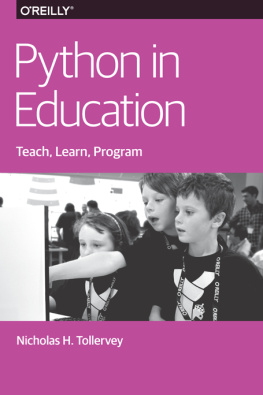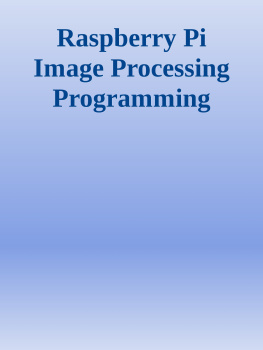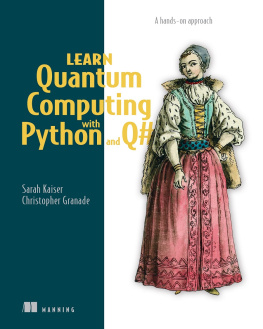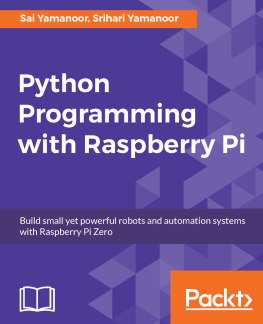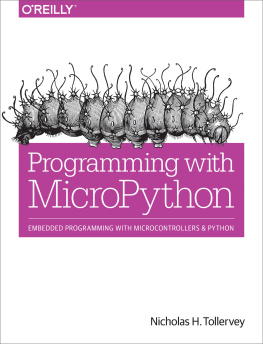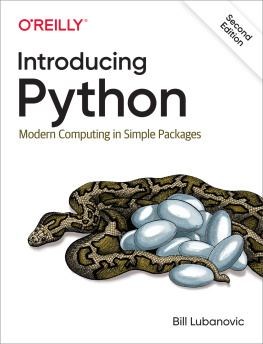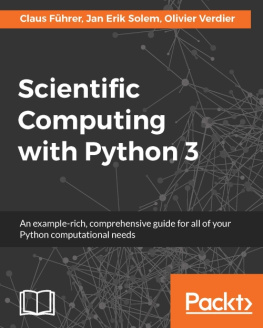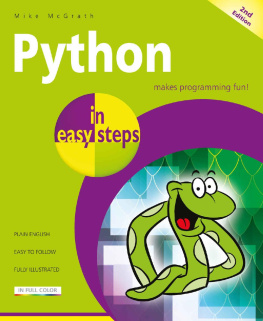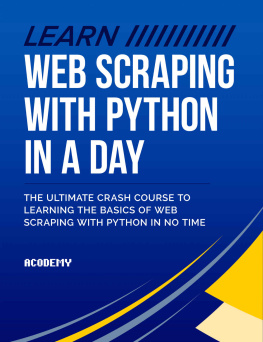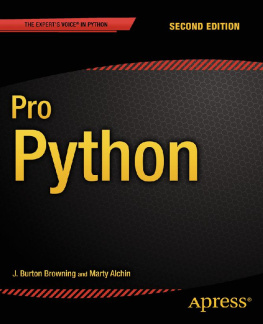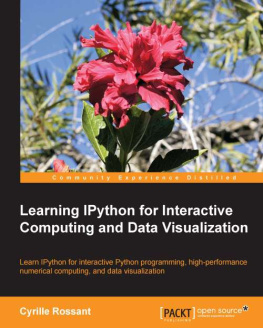Nicholas H. Tollervey - Python in Education
Here you can read online Nicholas H. Tollervey - Python in Education full text of the book (entire story) in english for free. Download pdf and epub, get meaning, cover and reviews about this ebook. year: 2015, publisher: OReilly Media, genre: Home and family. Description of the work, (preface) as well as reviews are available. Best literature library LitArk.com created for fans of good reading and offers a wide selection of genres:
Romance novel
Science fiction
Adventure
Detective
Science
History
Home and family
Prose
Art
Politics
Computer
Non-fiction
Religion
Business
Children
Humor
Choose a favorite category and find really read worthwhile books. Enjoy immersion in the world of imagination, feel the emotions of the characters or learn something new for yourself, make an fascinating discovery.
- Book:Python in Education
- Author:
- Publisher:OReilly Media
- Genre:
- Year:2015
- Rating:4 / 5
- Favourites:Add to favourites
- Your mark:
- 80
- 1
- 2
- 3
- 4
- 5
Python in Education: summary, description and annotation
We offer to read an annotation, description, summary or preface (depends on what the author of the book "Python in Education" wrote himself). If you haven't found the necessary information about the book — write in the comments, we will try to find it.
Python in Education — read online for free the complete book (whole text) full work
Below is the text of the book, divided by pages. System saving the place of the last page read, allows you to conveniently read the book "Python in Education" online for free, without having to search again every time where you left off. Put a bookmark, and you can go to the page where you finished reading at any time.
Font size:
Interval:
Bookmark:
by Nicholas H. Tollervey
Copyright 2015 OReilly Media, Inc. All rights reserved.
Printed in the United States of America.
Published by OReilly Media, Inc. , 1005 Gravenstein Highway North, Sebastopol, CA 95472.
OReilly books may be purchased for educational, business, or sales promotional use. Online editions are also available for most titles (http://safaribooksonline.com). For more information, contact our corporate/institutional sales department: 800-998-9938 or corporate@oreilly.com .
- Editor: Meghan Blanchette
- Production Editor: Kristen Brown
- Copyeditor: Gillian McGarvey
- Interior Designer: David Futato
- Cover Designer: Karen Montgomery
- Illustrator: Rebecca Demarest
- April 2015: First Edition
- 2015-03-11: First Release
The OReilly logo is a registered trademark of OReilly Media, Inc. Python in Education, the cover image, and related trade dress are trademarks of OReilly Media, Inc.
While the publisher and the author have used good faith efforts to ensure that the information and instructions contained in this work are accurate, the publisher and the author disclaim all responsibility for errors or omissions, including without limitation responsibility for damages resulting from the use of or reliance on this work. Use of the information and instructions contained in this work is at your own risk. If any code samples or other technology this work contains or describes is subject to open source licenses or the intellectual property rights of others, it is your responsibility to ensure that your use thereof complies with such licenses and/or rights.
978-1-491-92462-4
[LSI]
In memory of John Pinner (19442015), who tragically lost his fight with cancer while this work was being written.
He taught Python to me and many other people in the UK. This kind and gentle man understood the value of computing education and, through his work as founder and chairperson of the PyconUK conference, promoted it with great zeal.
He is a sorely missed mentor, leader and friend.
- 2. A Pythonic Case Study:
Raspberry Pi
Programming is cool.
Why?
Because programmers are obviously black-clad kung-fu ninjas with hacker aliases who always take the red pill, type really fast to crack databases, and save the world from renegade artificial intelligences. Also, why is programming such a boy thing?
Stereotypes stop people from doing stuff.
This applies as much to programming as any other aspect of life. If your view of a programmer is as ridiculous as the stereotypes listed above, then programming is likely to appear as an intimidating form of technical magic or a dull obsession for misfit boys who avoid the great outdoors.
But there is hope: the damaging prejudices and misconceptions listed above can be overturned through education. Organizations such as the RaspberryPi Foundation and One Laptop Per Child (OLPC) project see programming as a means of empowerment. A new generation of programmers are learning to be enterprising digital makers and creators rather than merely passive users. Even politicians are waking up to the realization that the long-term viability of their countrys economy and public services fundamentally depends on citizens ability to excel in the digital realm. And so educators have been tasked to change the school computing curriculum from an uninspiring Microsoft Office how-to into an education that includes programming, taking control of the computer and making it do things where the only encumbrance is ones imagination.
There is a programming language whose creator has explicitly said that his aim is to make computer programming for everybody. That person is Guido van Rossum, and the programming language is Python.
A quick glance online suggests that Python is the language du jour for teaching programming. Yet Python is, and has been for a while, one of the worlds most popular programming languages in industry as well. Every day, without realizing it, you probably use software that is written using Python. Python is used by companies to write all sorts of applications. Google, NASA, Bank of America, Disney, CERN, YouTube, Mozilla, The Guardianthe list goes on of companies and organizations of all sizes in all sectors of the economy that use Python.
Why is Python so popular?
I aim to answer this question from an educational perspective. One might distill the answer into the following points:
ResourcesThere are lots of resources for learners of all ages and levels. These range from traditional textbooks to websites that offer online self-paced courses in Python programming. With the advent of the Raspberry Pi and OLPC projects, everyone can get hold of affordable hardware that runs Python.The Languages DesignPython is easy to learn, intuitive, pleasing to the eye and comes with a plethora of libraries that allow programmers to build all sorts of applications addressing different domains and activities. Its easy to read: if you squint a little, most Python code is comprehensible even to people who wouldnt call themselves programmers (for example, Python is very popular among scientists).CommunityPython has a large, diverse and proactive community associated with it. The Python Software Foundation (PSF) is a community-led charitable organization whose mission is to promote, protect and advance the Python programming language.MomentumBeing popular is itself a strength and a virtuous circle that reinforces Pythons popularity. New projects and initiatives are announced all the time. For example, the author is aware of several yet-to-be publicly announced Python-in-education projects. The online version of this document will be updated to reflect these announcements, so be sure to check http://www.oreilly.com/programming/free/python-in-education.csp.If youre reading this report, I imagine youre a programmer, teacher, student, parent or other interested party. Youre probably wondering how this report will help you understand Pythons place in the recent resurgence of interest in computing education. Assuming the categories of reader listed above, heres whats in it for you.
If you already know how to write code, then you might believe that education is of little interest to you.
But wait!
If youre a good programmer, you also know that part of the vocation of software development involves learning new technology and, when in a position of responsibility, teaching junior colleagues how your software works. Put simply, to be a programmer is to be both a teacher and a student.
To describe programming so children understand you indicates that you know your craft at a deep level. For instance, you appreciate what to leave in or how much to leave out of an explanation. You have clear enough mental models of the concepts of programming that you can accurately analogize and summarize. Furthermore, you explain yourself in simple and easy-to-understand language that demonstrates your own clarity of thought. Finally, finding the opportunities to practice these skills on young coders is a sign of moral and professional value: youre putting something back into the wider community and have shown initiative.
This report describes how you and your colleagues may continue your professional development by supporting the next generation of programmers.
Well done! Before becoming a programmer, I was a senior secondary school teacher in the United Kingdom. It was the most difficult yet also most rewarding job I have ever had to do. Teaching is the one profession that creates all the other professions. It is a calling (youre certainly not doing it for the money or perks) and, as a practitioner of this remarkable profession, if youre looking for help and support in teaching programming, then youve made a great choice by investigating Python.
Font size:
Interval:
Bookmark:
Similar books «Python in Education»
Look at similar books to Python in Education. We have selected literature similar in name and meaning in the hope of providing readers with more options to find new, interesting, not yet read works.
Discussion, reviews of the book Python in Education and just readers' own opinions. Leave your comments, write what you think about the work, its meaning or the main characters. Specify what exactly you liked and what you didn't like, and why you think so.

